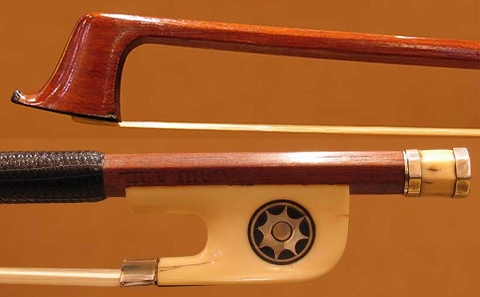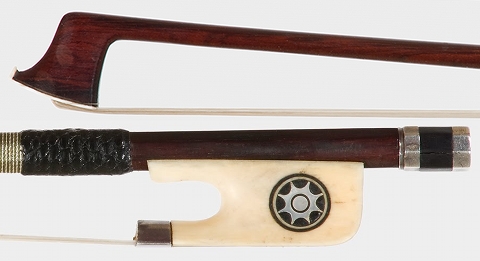FRANCOIS JUDE GAULARD; MAN OF THE SUNEven though the first curve model of the modern bow arrived from Germany - the famous “Cramer” - the evolution within bow making would have been quite complicated without personalities like Tourte and Persoit; Gaulard demonstrates this.
Violin bow by Francois Jude Gaulard, stick in pernambuco and frog in ivory with sun, 1820/25 I have nothing against Gaulard, on the contrary. He was a craftsman with an excellent manual capacity and didn't have a bad taste in style; the problem was his delay by half a century. He was born in Mirecourt on the 28th of October 1787, son of the violin and bow maker, Louis Gaulard and Marie-Jeanne Drouillet. As shown in the photo he began at a very young age as an apprentice by Louis Simon Pajeot of whom he inherited the style. On the 6th of June he married Ursole Fetique with whom he had two children; Louis Auguste and Nicolas Alexadre. Nicolas Alexadre also became a violin maker and died in Algeria. Gaulard remained in Mirecourt for the most of his life, the towns commercial archives shows that he was accredited there as a bow maker until 1854/55. When his wife died on the 18th of January 1855, he decided to move to Troyes where his son, Louis Auguste, had a music shop. He kept on making bows until his death, on the 4th of February 1857. The bows Gaulard was a craftsman with undoubted technical capability, but he is usually placed some levels under the greatest craftsmen of French bow making. Although Gaulard had great manual skills, the reason to this is that he didn't evolve his work in a period where the modifications of the psychical structure of the bows was in a continuous change. Observing the work of Gaulard, and not only the ones done in his youth, you could date the works to be contemporary to his teacher', Louis Simon Pajeot, instead they were made by his son Etienne. Tourte and Persoit had practically completed the development of the modern bow in Paris, whereas a guideline was missing in Mirecourt. Even though the modern curve hadn't been developed in Paris, the work of Francois Xavier Tourte was fundamental, particularly referring to the mechanism of the frog and how he by changing its shape obtained a more resistant structure. The frogs made by Gaulard are as beautiful as the ones made by his teacher and the ones made by Etienne in the beginning, but they have an enormous problem in the solidity of the structure. Mainly because of the material in which it was made; ivory. The first modern frogs didn't have the drawstring in silver to protect the octagon. And because of the fragility of the ivory and greater elasticity of the newfound wood, the Pernambuco, Francois Xavier preferred to abandon the ivory, immediately after the arrival of the “Cramer model” and replace with the more resistant ebony.
Violin bow by Francois Jude Gaulard, stick in pernambuco and frog in ivory with sun, 1815/20 Tourte, and the often forgotten personality; Jean Pierre Marie Persoit, realised that changing the material of the frog was not enough to sustain the power of the Pernambuco, and therefore the architecture of the bow had to be changed as well. The long pad became a weak point and the mechanic of it was useless. These modifications were made in Paris about 35 years earlier than the making of the bows in the photos. The different progresses of the two production centres continued until the arrival of another great violin bow maker; Etienne Pajeot. Thanks to the arrival of the 6 year younger Pajeot, who gave him quite some work to do, the violin bows' head began to close up slightly and differ from the classic bows of his teacher. Gaulard tried to do something about the frog, without ever completely abandoning the models of Louis Simon. To read more about this topic: So long, Paolo
|
   |







